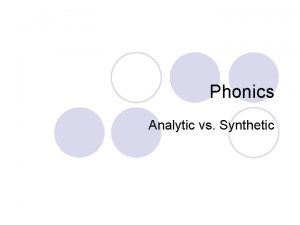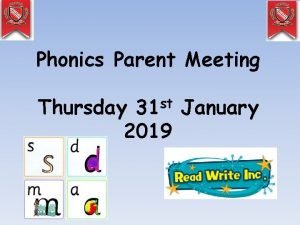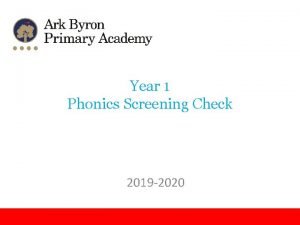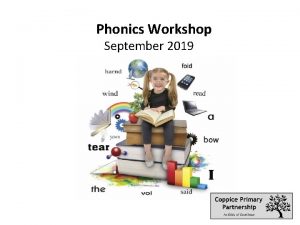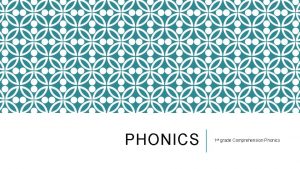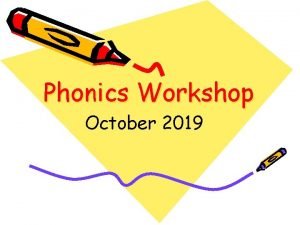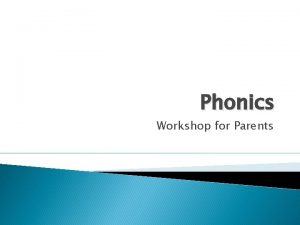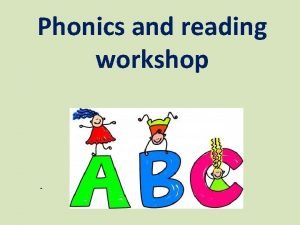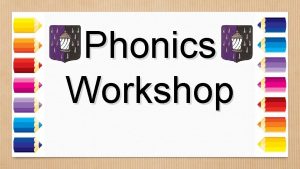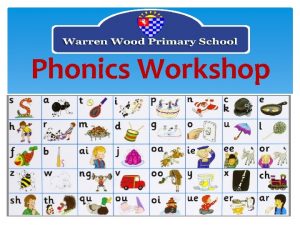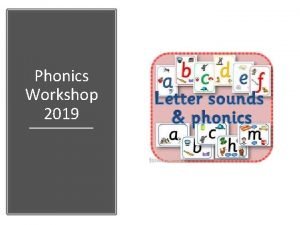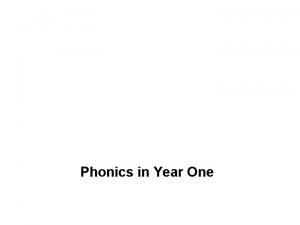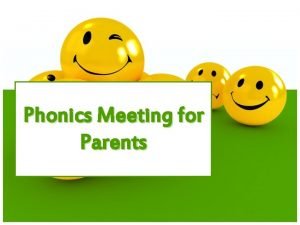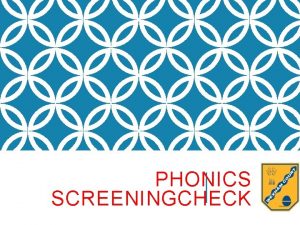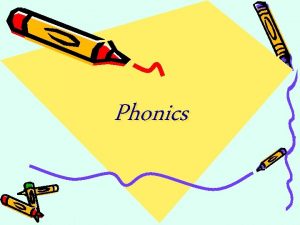Phonics Workshop January 2019 Phonics Aims of the



















- Slides: 19

Phonics Workshop January 2019

Phonics – Aims of the workshop v. What is Phonics? v. Words we use - Terminology v. Our school approach v. Phonics in our classrooms. v. Year 1 Phonics check v. Resources

What is Phonics? v The teaching of phonics is about teaching children the sounds of letters and then using these sounds to read and spell words. v Phonics is taught through daily phonics sessions. v All phonics lessons include oral blending and segmentation. v As well as teaching phonics we also teach High Frequency words and tricky words.

Terminology • Phoneme – a sound in a word • Grapheme – a letter or sequence of letters that represents a phoneme (kn-igh-t = 3 graphemes) • Digraph – two letters which make one sound – ch • Trigraph – three letters which make one sound – igh • • Blending - Hearing or reading sounds and merging (blending) them together to make a word. e. g. /b/u/s, they will say bus. • Segmenting – breaking down words into their sounds to spell – saying the word – bus, then hearing the sounds - /b/u/s.

Blending Building words from phonemes to read. c a t cat

Segmenting • Breaking down words for spelling. cat c a t

Our school approach In school, we follow the Jolly Phonics Scheme. We also use the Letters and Sounds document. This is a phonic resource published by the Department for Education and Skills which consists of six phases.

Reception Phase 1 – We give the children opportunities to experience regular, planned opportunities to listen carefully and talk extensively about what they hear, see and do. this should be on-going through the year and even into Year 1 and 2 for some children. Examples of activities – Nursery Rhymes, listening walks and games, distinguishing between sounds, blending and segmenting sounds. Phase 2 – We start to teach the children the sounds of the letters and straight away we begin to blend and segment these. We teach these in the order given in the Letters and sounds document.

Reception Phase 2 - s, a, t, p i, n, m, d, g, o, c, k ck, e, u, r Phase 3 - j, v, w, x, y, z, zz, qu, ch, sh, th, ng, ai, ee, igh, oa, oo, ar, or, ur, ow, oi, ear, air, ure, er We also teach the children the individual letter names. We also teach children to read and spell common words. The children apply this straight away when reading and writing.

Reception Activities v During the Reception year we try to make phonics activities as practical as possible. We use resources such as chalks, large brushes and water, playdough, paints, games, magnetic letters, white boards. v Magnetic board - activity

Year 1 - Phase 4 • By Phase 4 children are able to represent each of 42 phonemes by a grapheme. Children will be able to blend and segment CVC words for reading and spelling. • Phase 4 is consolidation of children’s knowledge. Children are encouraged to practice blending for reading and segmenting for spelling of adjacent consonants.

Year 1 -Phase 5 • Children will be taught new graphemes and alternative pronunciations for these graphemes. • Vowel digraphs: wh, ph, ay, ou, ie, ea, oy, ir, ue, aw, ew, oe, au • Split digraphs: a_e, e_e, i_e, o_e, u_e

Year 1 Children are split into three smaller groups across the year group. Phonics takes place four/five times a week and the sessions last about 20 minutes. The sessions are fast paced and will have a specific focus. Each session has a specific structure as detailed in the Letters and Sounds Framework: v Revisit- children will recap the phonemes and high frequency words already taught. This is usually done with the use of flashcards. v Teach- the children are taught a new phoneme/s or high frequency word/s. These are displayed on a class whiteboard and the children are taught the sound, action and how to read/spell within a word. v Practise- Children are given the opportunity to practise using the phoneme/word, they do this by playing a reading/spelling game. v Apply- Children use the phoneme/word taught in a sentence. The teacher will say a simple sentence or caption and the children are expected to write this correctly on their whiteboards. The children will be tested on their phoneme recognition, segmentation and blending at the end of each half term.

Year 1 Example of Year 1 Phonics Activity Buried Treasure Using the following link https: //www. phonicsplay. co. uk/Buried. Treasure 2. html The children split their whiteboards into two and draw a ‘trash bin’ and ‘treasure chest’ at the top of each side. As a word appears on the interactive whiteboard, the children read it and decide whether it is trash or treasure. Children then write the word in the corresponding box on their whiteboards, with sound buttons added underneath. As a class, children read the word and decide if its ‘trash’ or ‘treasure’. Sometimes we will give the children a point for each correct answer.

Year 2 The children will revist Phase 5 and then cover Phase 6. Phase 5 Children will be taught new graphemes and alternative pronunciations for these graphemes. Vowel digraphs: wh, ph, ay, ou, ie, ea, oy, ir, ue, aw, ew, oe, au Split digraphs: a_e, e_e, i_e, o_e, u_e This phase is about broadening the children's knowledge of graphemes and phonemes for use in reading and spelling. Phase 6 The focus is on learning spelling rules for suffixes. -s -es -ing -ed -er -est -y -en -ful -ly -ment -ness This phase develops the children’s ability to read words automatically, decoding them quickly and silently. Children become fluent readers and increasingly accurate spellers.

Year 2 There will be some children in Year 2 working on previous phases especially if they did not achieve the required score on the Year 1 phonics check. These children will work regularly with the class TA and Mrs Bowditch, Miss Titterington and Mrs Thomas all take children for intervention sessions if they require extra help. Phonics and spelling are taught to all Y 2 children daily through daily literacy sessions.

Year 1 Phonics Test

Resources http: //www. phonicsplay. co. uk

Resources http: //www. teachyourmonstertoread
 Difference between synthetic and analytic phonics
Difference between synthetic and analytic phonics 2019 ib grade boundaries
2019 ib grade boundaries Phonics test 2019
Phonics test 2019 2019 phonics screening test
2019 phonics screening test Chúa yêu trần thế
Chúa yêu trần thế điện thế nghỉ
điện thế nghỉ Fecboak
Fecboak Một số thể thơ truyền thống
Một số thể thơ truyền thống Trời xanh đây là của chúng ta thể thơ
Trời xanh đây là của chúng ta thể thơ Sơ đồ cơ thể người
Sơ đồ cơ thể người Công thức tính thế năng
Công thức tính thế năng Số.nguyên tố
Số.nguyên tố đặc điểm cơ thể của người tối cổ
đặc điểm cơ thể của người tối cổ Tỉ lệ cơ thể trẻ em
Tỉ lệ cơ thể trẻ em Các châu lục và đại dương trên thế giới
Các châu lục và đại dương trên thế giới ưu thế lai là gì
ưu thế lai là gì Các môn thể thao bắt đầu bằng từ đua
Các môn thể thao bắt đầu bằng từ đua Tư thế ngồi viết
Tư thế ngồi viết Hình ảnh bộ gõ cơ thể búng tay
Hình ảnh bộ gõ cơ thể búng tay Cái miệng nó xinh thế
Cái miệng nó xinh thế
